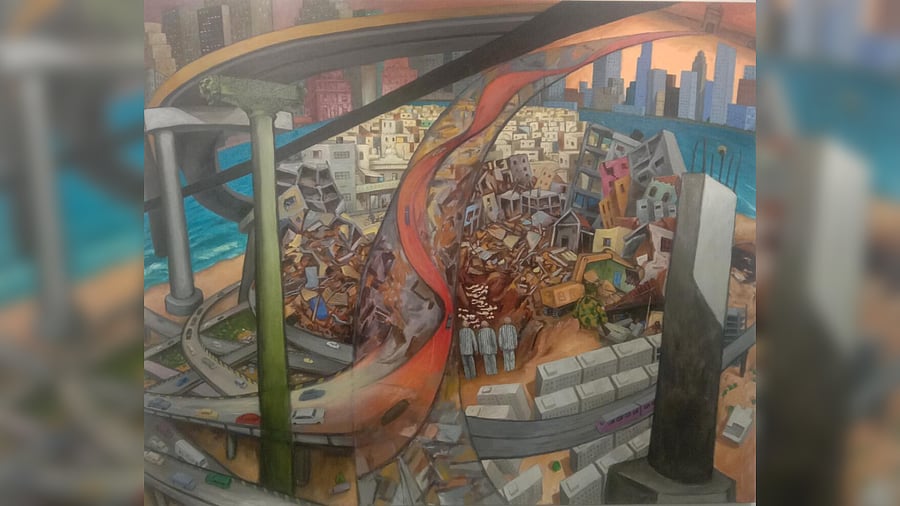
One of Patwardhan's works.
Credit: DH File Photo
In a utopian world, merit should be enough for a practitioner of any profession to find success. But in our ‘normal’ world, obsessed with brands and pedigrees, it is often an act of courage to launch oneself in a field where your success is measured only by lofty degrees and designations. Two examples of such courage in the field of Indian art are well-known artists Amit Ambalal and Sudhir Patwardhan, both of whose solo exhibitions were recently hosted by New Delhi’s premier galleries — Gallery Espace and Vadehra Art Gallery.
Ambalal and Patwardhan are two of India’s highly respected and self-taught artists, who did not enter the hallowed portals of any high-profile art school, yet have attained success that many can only aspire to. (Here, it is pertinent to mention one of their ilk, Maqbool Fida Husain — also a largely self-taught artist, who recently headlined the art world when his canvas Untitled (Gram Yatra) sold for Rs 118.62 crore, becoming one of the most expensive Indian works of art ever).
A quick walkthrough of both the exhibitions is enough for even the most lay admirers of art to comprehend what makes Amit Ambalal and Sudhir Patwardhan the successful and celebrated artists they are. After all, they have both been at it for decades: Ambalal, now 81, liquidated his family business of textiles to pursue his passion for painting at the age of 36, whereas Patwardhan, now 75, is a practising radiologist who became a full-time artist in 2005.
While Ambalal gives expression to the little pleasures of la vie quotidienne (ordinary, day-to-day life), mostly depicted through a monkey at its naughtiest in his most recent exhibition, Patwardhan trains a more serious eye on the rampant construction in the city of Mumbai, which is a city perpetually being built as long as one can remember. Both their artworks delight, engage, and provoke the onlooker to pause and think, drawing them in with their directness, and leave one spellbound, just as works by any trained artist would.
“Honestly, I have not cared whether an artist is trained or not as long as their art can engage the viewer and the artist knows what they are doing,” says Renu Modi, founder and director of Gallery Espace, which turned 35 last year. “In all these years, I have always followed my instinct, and fortunately, it has stood me in good stead,” she adds.
Ahmedabad-based Ambalal’s recent works at Gallery Espace delighted with their sheer execution, where their subject played only a supporting role in engaging the viewer. The exhibition featured over 30 paintings made by the artist in the past two years, mostly watercolours and acrylics on canvas. Wit and humour have been the leitmotif of Ambalal’s art, which was amply on display at his latest solo. It is perhaps the raw playfulness that he imbues his canvases with that makes his art stand out in the universe of contemporary Indian art.
While Ambalal has carved a niche for himself in representing the droll realities of life with his distinctive style of humour, Patwardhan, on the other hand, has steadily yet firmly built his reputation as a chronicler of life in the city of Mumbai (among other subjects that he paints). A graduate of the Armed Forces Medical College, Pune, Patwardhan began painting full-time in 2005. “Though I did not train as an artist, I consulted my painter friends throughout my journey, which helped me in perfecting my skills and style,” says Patwardhan, whose exhibition, ‘Cities: Built, Broken’, after showing in New Delhi, was on view at Jehangir Art Gallery, Mumbai, till recently.
Patwardhan says that the city of Mumbai always enchanted him with its varied and richly layered identities, but it’s the aspect of it being under construction at all times that engrossed him strongly. “It’s a densely populated city wherein people move here and there on their chores in great numbers through the day, throughout the year. My art brings focus on individuals as they navigate their way through this maze while going about their daily lives. The landscape of their neighbourhood undergoes a rapid change while they go about their work; many new structures come up and older ones disappear as they manoeuvre and adjust their lives with the changing physical realities,” he explains.
This is brought about most succinctly in his latest works on the subject, where a human figure often finds itself wedged in between bamboo scaffoldings and iron and steel girders, giving shape to mammoth structures. The rush of humans going about their daily chores while navigating their way through routes rendered precarious due to construction material strewn around, even as motor vehicles of all sizes seem to honk their way onward in this maze, is brought out with great attention in Patwardhan’s works. One can almost hear the crazy buzz of a megacity like Mumbai while looking at his works in the silent ambience of a gallery.
What makes both Ambalal and Patwardhan instantly relatable is their ability to connect with the mundanity of human existence through their art, which, despite being laden with meanings, is as direct as it can get for even a lay admirer of art. It is not puerile, perhaps, to conjecture that their lack of institutional training may have had a role to play in their ability to remain true to real life.